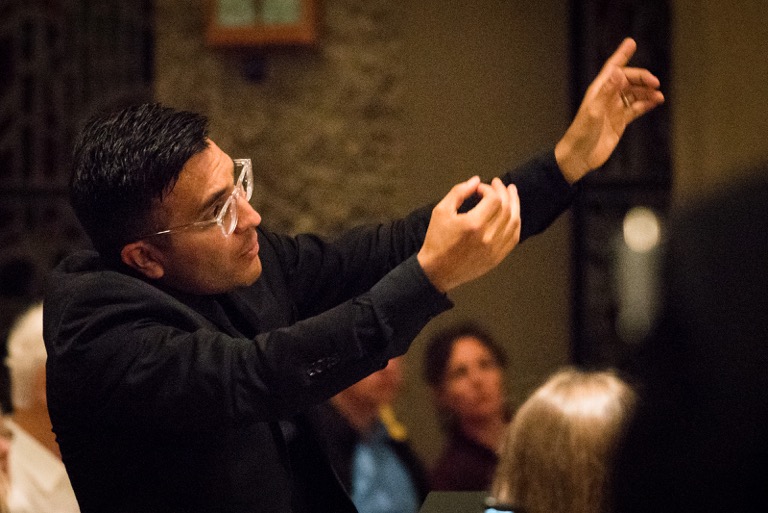Bach Collegium San Diego Gives Stirring Concert of C. P. E. Bach and Georg Philipp Telemann
The Bach Collegium San Diego opened it 21st season Friday at All Souls’ Episcopal Church in Point Loma with two major 18th-century masterpieces, late works by Georg Philipp Telemann and C. P. E. Bach. Emanuel Bach’s 1788 Concerto Doppio in E-flat Major for Harpsichord and Pianoforte, Wq 47, is well known because it features the 18th-century’s innovative keyboard, the fortepiano, in tandem with the harpsichord, the keyboard instrument it was then replacing throughout Europe. Music history texts regularly point to C. P. E. Bach’s Double Concerto as a work that symbolically enthroned the fortepiano and sent the harpsichord packing.
On the other hand, Telemann’s rarely encountered dramatic secular solo cantata from 1765 Ino, TWV 20:41, has eluded even the music historians. Kudos to Artistic Director Ruben Valenzuela for bringing this cantata to his loyal San Diego audience.The Double Concerto featured Boston-based artists harpsichordist Michael Sponseller and Sylvia Berry on fortepiano. As a regular member of the Bach Collegium’s orchestra, Sponseller’s keyboard finesse is perhaps taken for granted by regular members of the Bach Collegium audience, and although Sylvia Berry has given solo fortepiano recitals here, Friday’s concert was the first time I was able to hear her artistry in person.
These two keyboard players proved elegantly matched in their verve, acute sense of period style, and sparkling technique. Their prowess combined with Valenzuela’s spirited direction of the 16-member Bach Collegium orchestra gave the galant work an exciting, highly rewarding presentation.
Hearing these two keyboard instruments of similar size playing side by side in this concerto gave an insightful comparison of their different sonorities. Concert-goers familiar with the robust sonic power of the modern concert grand may assume that the fortepiano overtook the harpsichord simply because it was much louder that the harpsichord. In truth, to judge by the two instruments heard on Friday, the fortepiano’s dynamic level was quite equal to that of the harpsichord. The difference, however, was in the quality of sound that each instrument produced. The fortepiano’s timbre is characterized by a strong fundamental tone that stays in the room longer than the harpsichord’s sound, whose initial pluck can produce a sound of bright high overtones but seriously deficient in fundamental tone. The harpsichord’s sound simply does not linger. This explains why, for example, a slow harpsichord piece must be lavishly ornamented, i.e. fortified with an immense amount of rapid figurations, or it is dead in the water. The fortepiano produces a winning, singing tone that does not evaporate after it is struck.
C. P. E. Bach’s charming work has in common with Johann Sebastian Bach’s concertos an admirable sense of structure, although in place of his father’s fertile counterpoint, Emanuel offers a cornucopia of short, snappy themes. In the opening “Allegro di molto” the two keyboards traded jaunty, sprightly flourishes, although the antiphonal flourishes by the transverse flutes proved equally if not more attractive—kudos to Stephen Schultz and Lars Johannesson. The gentle middle movement, “Larghetto,” seemed blandly static, but the rousing “Presto” finale made up for that with a barrage of driving themes from the strings, horns, and flutes, as well as brilliant fortepiano writing executed with exciting panache by Berry. The Bach Collegium’s vibrant account of this iconic work could not have been more satisfying.
Perhaps the most prolific of 18th-century composers, Telemann—unlike his compatriot J. S. Bach—held important positions with prominent churches and opera companies. So it is no surprise that his secular cantata Ino, based on a complicated mythological story from Ovid’s Metamorphoses—is a dramatic tour de force. We heard soprano Clara Rottsolk sing in the Bach Collegium’s superb account of J. S. Bach’s St. Matthew Passion earlier this year, and it was rewarding to hear more of her vocal artistry in this demanding solo cantata. From her strong declamation in the cantata’s opening rage aria to her exceptionally graceful cadenza in her penultimate aria, her limpid, ever confident vocal line and ingratiating dynamics kept the listener engaged in the saga of Ino’s journey to divinity.
Telemann’s inventive instrumental writing takes a back seat to none in that fertile mid 18th-century period. His vigorous dances, colorful recitative accompaniments, triumphant odes—even his deft depictions of waves on the sea—played to the strengths of the Bach Collegium orchestra under Valenzuela’s insightful direction.
The program opened with Franz Xaver Richter’s Adagio and Fugue in G Minor, led by concertmaster Elizabeth Blumenstock with maestro Valenzuela at the harpsichord. Richter was traditional enough to take seriously the composition of a fugue, yet his sweeping, descending fugue subject had a carefree galant feel to it. The strings of the Bach Collegium orchestra gave a warm, inviting account of this cheerful piece.
The Bach Collegium of San Diego presented this concert on October 20, 2023 at All Souls’ Episcopal Church in San Diego and repeated the program on October 21 in Cardiff.


Insightful, educational, and elegant, as always. Thank you. Elizabeth Blumenstock brought great energy and spice to the leadership position. During rehearsal it was eye opening to see and hear her make a difference.
Thank you Lee for calling the reader’s attention to the fine playing and leadership of Concertmaster Elizabeth Blumenstock. I should have given her well-earned praise for the buoyant, disciplined sound of BCSD’s string ensemble. That quality is the very center of everything BCSD performs.